This book contributes to the literature on Geographical Indications (GIs) by providing key theoretical reflections from a five-year review process on the potential of GIs for agri-food products in Southern Africa. The contributors reflect on diverse GI processes and dynamics which operate at the local, national and international levels, thus enriching the understanding of GI dynamics and of the variety of policy options available for GI protection in Southern countries. Following a discussion of the legal framework and governance of national GI schemes in Southern countries, the book emphasizes the main dimensions underlying the development of GIs and their potential for enhancing sustainable rural development and market access in particular. This provides the structure for the chapters that build on the different experiences of Southern African industries that have embarked on GI strategies. The book includes chapters on designing an appropriate legal framework and governance system for the development of GIs in Southern countries.
Daftar Isi
Preface.- 1. Why the need to consider GIs in the South? .- 2. Designing an appropriate legal framework and governance system for GI development in Southern countries.- 3. Collective action dynamics and product reputation.- 4. Private versus public quality schemes for origin-labelled products: Insights from the Karakul pelts and Camdeboo mohair industries.- 5. Institution building and local industry dynamics: Lessons from the Rooibos GI initiative.- 6. Guidelines for selecting successful GI products.












